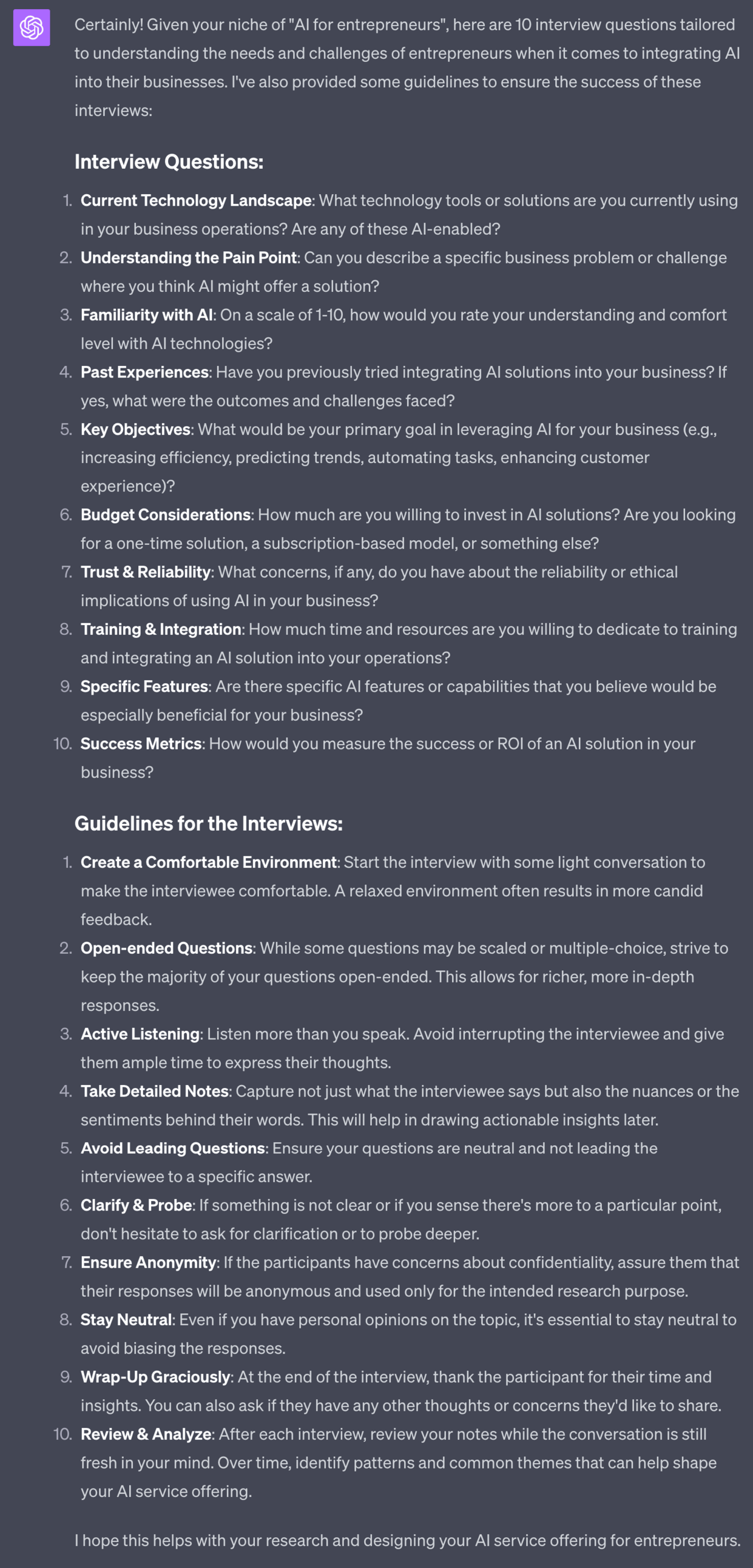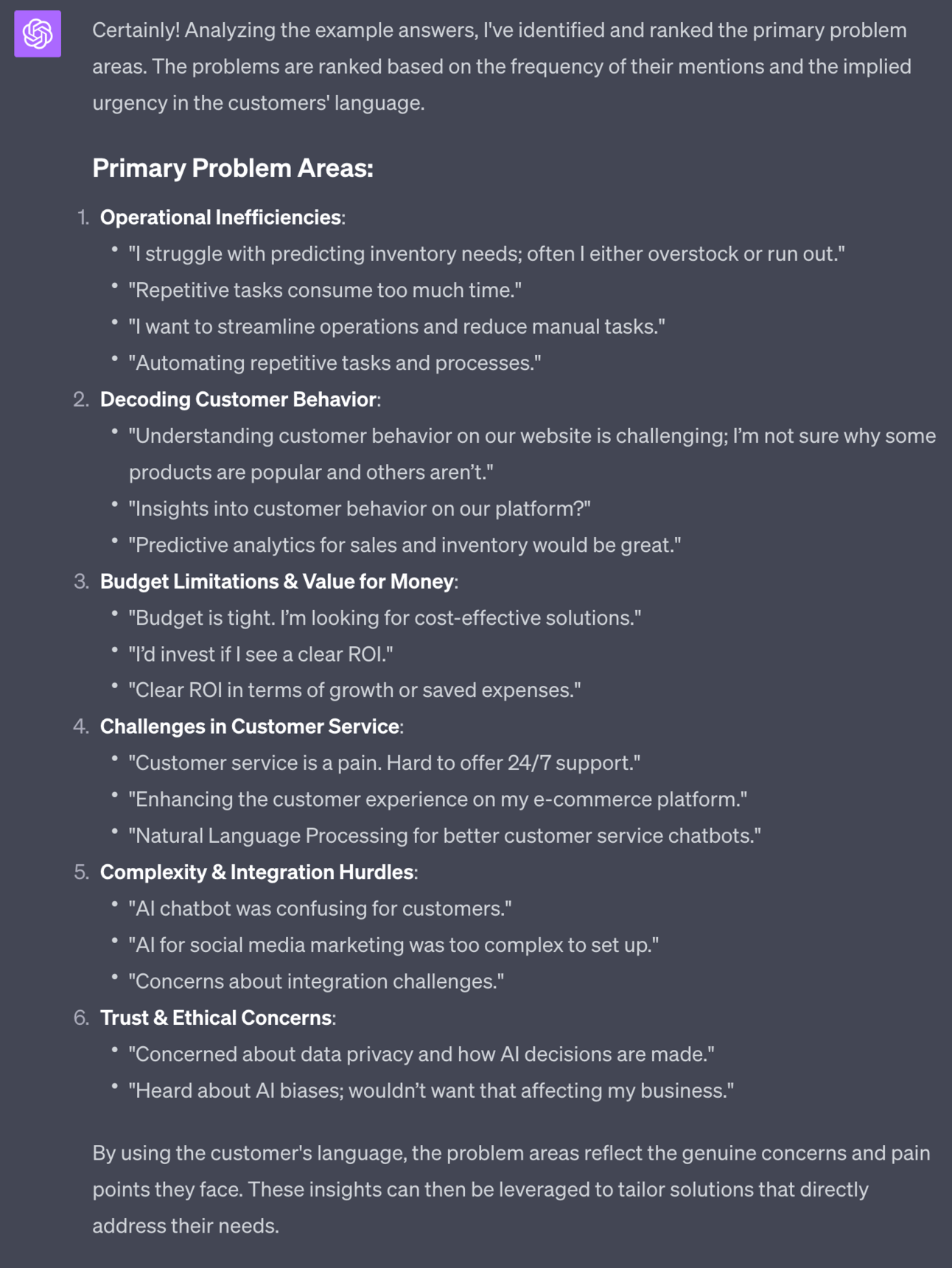Hey Prompt Entrepreneur,
This week we’ll design, deploy, market and scale up a service offering for your business. All using AI to aid our progress and operations.
Let’s get started:
Service Offer Ideas
1. Services vs. products
It’s worth quickly talking about the difference between services and products.
This will help us focus on what a service should achieve – and thus let us design better services.
Both products and services deliver a valuable outcome to the customer.
Customers make a purchase because they want a certain outcome – for example they want to lose weight, look cooler, be more educated.
And they value this outcome enough to pay us for it.
The main different between a product and a service is how this valuable outcome is delivered.
Some products – like a book or a hammer – are easy to identify.
Some services – a haircut or car service – are equally identifiable.
But what about something like Squarespace. It’s sort of a product and a service. Online lines get blurred.
I like to use a scale of DIY, DWY and DFY here.
Products and services all sit along this scale.
DIY you probably know – Do It Yourself.
Most products are DIY. You buy the product and use it yourself. If it’s a book you read and absorb it’s information. If it’s an Ikea wardrobe you buy the kit and make it yourself.
There’s no outside intervention with DIY products – you are on your own.
DFY is Done For You.
Most services are Done For You. A haircut for example you turn up and the hairdresser provides the service for you. Your input is minimal as you let them do the work for you. A massage is another DFY service.
These two are nice and obvious and represent pure products and pure services.
But there’s a middle group – DWY or Done With You.
These are more hybrid products/services. They offer DIY and DFY elements.
In web design for example we have:
- DIY – creating your website from scratch.
- DWY – using a service like Squarespace.
- DFY – hiring a web site designer.
A service like Squarespace sits in the weird middle ground between product and service.
It’s a productised service – neither a pure product nor a pure service. You have access to all their tools, templates, infrastructure and support (service) but still need to do the actual work yourself (product).
The course I’m preparing at the moment is another example.
There are DIY elements of a product (the course material for you to work through at your own pace) but also DWY elements like a community where you can talk with me and get guidance. It’s mixing service and product.
Increasingly it’s helpful to think of your offer in these terms – not just black and white product and service but instead allowing for hybrids.
The keystone here is what helps your customer achieve their valuable outcome.
This is all that matters.
2. How products and services combine
Because both products and services are aimed at achieving specific outcomes for a customer we should be combining them to best get our customer that outcome.
My recommendation is this.
When first starting a business start with a service not a product.
This is because with a service you can:
- start with very little required cash
- launch quickly
- immediately solve customer problems
- learn what customers commonly struggle with
- refine your offer as you learn
Products take longer and cost more to develop and deploy. Which means it’s a riskier way to start a business.
With either a product or a service launch we need to be flexible and adapt quickly to what our customers are responding to. This is simply much easier to do with a service than it is with a more fixed product.
Once we have a service offer that is working and popular we then look to create a product that captures the same value and solves the same customer problems.
An example is helpful.
I work with charities and companies who want to deploy AI in their operations. I sit with them and consult as a service.
Once I had consulted with enough companies I could see the same problems coming up again and again.
Based on this knowledge I then created products that addressed these problems.
If I had instead developed products I would not have had all the experience and learnings about my customers that come from providing a service.
Once the product is deployed what happens to the service? Great question!
The service now becomes my more premium offer.
I decrease availability and raise prices. The product becomes the lower cost, entry offer.
I use the product to drive leads to my service.
This strategy is quite complex so here’s a summary:
- Deploy a service offer first
- Use learning from the service to build a product
- Increase price of the service and make it our second offer
- Use product as the first offer
- Put up-sells in the product to sell the service
We’ll be using this strategy in this Playbook as we develop our service offering.
The service we design now will initially be our first offer.
Then it’ll shift and become a premium offer as we scale up our business.
3. Customer interviews
First we need to hone in on what problems our customers’ actually have.
The only way to know this is to ask them.
You can run polls on Twitter/X, LinkedIn and in your newsletter.
But for a service offering I would recommend interviewing potential customers.
Sounds like a lot of work?
It is.
But it’ll save you countless months of chasing the wrong objectives.
Doing these interviews in person or on a call is ideal. This lets you hear their unfiltered language, which is key. We need this to know how to speak to them about the offer later. But you can also send over the questions via email if you really have to.
Here’s a prompt for generating interview questions:
Act a market research expert
I am doing interviews to help me design a service offering
The service offering should help the customer solve a problem
The service offering niche is [topic]. Tailor to this niche.
Generate 10 questions as well as guidelines for the interviewsFor the example I plugged in “AI for entrepreneurs” as the topic.
💬 Prompt Output

This generates not only niche specific questions but also some basic guidelines for carrying out the interviews.
4. Distill to problems
Once you’ve carried out your interviews we want to distill to the problem areas that recur across our customers.
The more interviews you do the more data you’ll have.
You may already have a fair idea of the problem areas just from talking to customers. But let’s feed all the data back into ChatGPT to extract the problem areas.
Put all of the interviews into one document and upload it to GPT-4’s Advanced Data Analysis tool if you have lots of data.
Otherwise just copy paste it all in.
Let’s then use this prompt:
Act as an expert market researcher
From these customer interviews extract the primary problem areas
If possible rank them by their importance to the customers
Use the customer's language to name the problem areas💬 Prompt Output

The prompt pulls the problem areas out of my data and orders them by their frequency. The most mentioned are at the top of the list and are presumably the most important to our customers.
5. Service ideas
Let’s now take our customers’ problem areas and convert these into potential service offer ideas.
We’ve done most of the hard work so now we use a simple prompt to brainstorm.
Use this prompt:
Act as a service design specialist
Based on the identified customer problem areas generate a list of 10 service offerings I could provide.
For each provide name, description, hours required to provide, price to charge, scalability, low/medium/high value offer based on interview data.
Aim for a range of services with low to high price.
My hourly rate is [$], build in a 3x profit margin.Use this prompt below the problem area output from the last prompt.
Make sure to add in your hourly rate to help price up the services too.
💬 Prompt Output

ChatGPT will take all your research and generate 10 potential service offerings.
These are aligned with what your customers perceive to be their problems. These service offerings will therefore be simple to market to customers.
I’ve also set up the prompt to give a range from low cost to higher cost to give you options.
Your job now is to review the options and decide which services i) you have the skill for and ii) you would enjoy providing. These are the most basic criteria for making a selection.
Tomorrow we’re going to start to design the offering based on the idea you choose.

5. Premium Prompt – Delving into true customer fears and dreams
Subscribe to the Premium Membership to read today’s Premium Prompt on how to add high-ticket services to our product mix.
Pulling it together
A reminder of what we’re covering this week :
Part 1: Service offer ideas
Part 2: Design your service offer
Part 3: Deploying your service offer
Part 4: Market your service
Part 5: Premium service offer expansion
